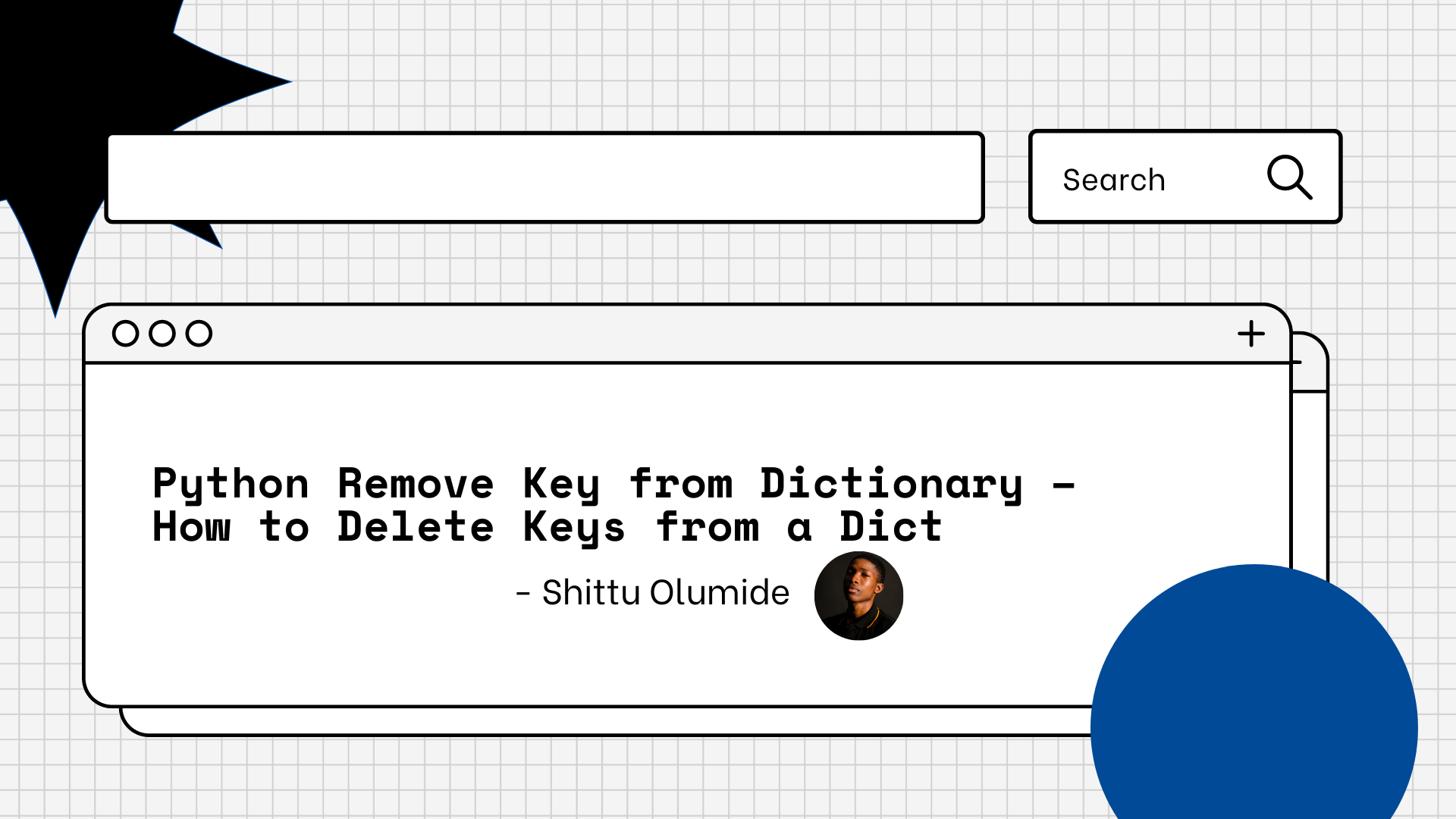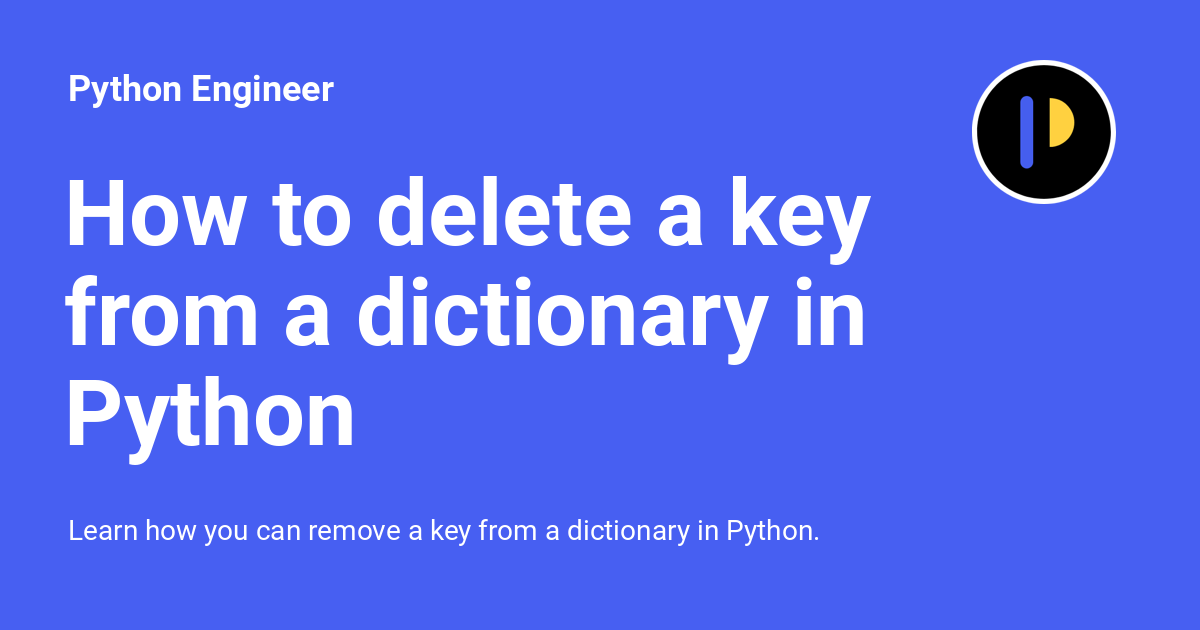Python Dictionary: How to Remove a Key
Learn different methods to efficiently remove keys and their corresponding values from Python dictionaries in this comprehensive guide.
Learn different methods to efficiently remove keys and their corresponding values from Python dictionaries in this comprehensive guide.
In Python, dictionaries are mutable data structures that store data in key-value pairs. There are several ways to remove a key-value pair from a dictionary: using the del keyword, the pop() method, or dictionary comprehension. Each method offers a slightly different approach and use case.
Using the del keyword: This is the most straightforward way to remove a key-value pair from a dictionary.
my_dict = {'a': 1, 'b': 2, 'c': 3}
del my_dict['b']
print(my_dict) # Output: {'a': 1, 'c': 3}If the key does not exist, it will raise a KeyError.
Using the pop() method: This method removes the specified key and returns the corresponding value.
my_dict = {'a': 1, 'b': 2, 'c': 3}
value = my_dict.pop('b')
print(my_dict) # Output: {'a': 1, 'c': 3}
print(value) # Output: 2If the key is not found, it will raise a KeyError. To avoid this, you can provide a default value as a second argument:
my_dict = {'a': 1, 'b': 2, 'c': 3}
value = my_dict.pop('d', None)
print(my_dict) # Output: {'a': 1, 'b': 2, 'c': 3}
print(value) # Output: NoneDictionary comprehension: This approach is useful when you want to create a new dictionary without certain keys from an existing dictionary.
my_dict = {'a': 1, 'b': 2, 'c': 3}
new_dict = {k: v for k, v in my_dict.items() if k != 'b'}
print(new_dict) # Output: {'a': 1, 'c': 3}This iterates through the key-value pairs of the original dictionary and only includes those whose key is not 'b' in the new dictionary.
Important Note: Modifying a dictionary while iterating over it can lead to unexpected behavior. If you need to remove items based on certain conditions while iterating, it's safer to iterate over a copy of the dictionary or collect the keys to remove first and then delete them.
This Python code demonstrates four ways to remove a key-value pair from a dictionary: using the 'del' keyword, using the 'pop()' method (with and without a default value), and using dictionary comprehension to create a new dictionary without the desired key-value pair. Each method is shown with an example and its corresponding output.
# Using the 'del' keyword
my_dict = {'a': 1, 'b': 2, 'c': 3}
del my_dict['b']
print("Using 'del':", my_dict) # Output: {'a': 1, 'c': 3}
# Using the 'pop()' method
my_dict = {'a': 1, 'b': 2, 'c': 3}
value = my_dict.pop('b')
print("Using 'pop()':", my_dict) # Output: {'a': 1, 'c': 3}
print("Removed value:", value) # Output: 2
# Using 'pop()' with a default value
my_dict = {'a': 1, 'b': 2, 'c': 3}
value = my_dict.pop('d', None)
print("Using 'pop()' with default:", my_dict) # Output: {'a': 1, 'b': 2, 'c': 3}
print("Removed value:", value) # Output: None
# Using dictionary comprehension
my_dict = {'a': 1, 'b': 2, 'c': 3}
new_dict = {k: v for k, v in my_dict.items() if k != 'b'}
print("Using dictionary comprehension:", new_dict) # Output: {'a': 1, 'c': 3}This code demonstrates all three methods for removing key-value pairs from a dictionary in Python, along with clear explanations and output for each method.
Choosing the right method:
del when you want to simply remove a key-value pair and don't need the removed value.pop() when you want to remove a key-value pair and also use the removed value in your code.Error handling:
del and pop() raise a KeyError if the specified key doesn't exist.in keyword to check for the key's existence before attempting to remove it, or use pop() with a default value to avoid errors.Alternatives to dictionary comprehension:
Shallow vs. deep copy:
copy.deepcopy() if you need to create a completely independent copy of the dictionary and its contents.Performance considerations:
del and pop() are generally faster than dictionary comprehension for removing a single key-value pair.This article outlines three ways to remove key-value pairs from a Python dictionary:
| Method | Description | Error Handling | Modifies Original |
|---|---|---|---|
del dict[key] |
Simplest method, removes key-value pair directly. | Raises KeyError if key doesn't exist. |
Yes |
dict.pop(key[, default]) |
Removes key-value pair and returns the value. | Raises KeyError if key doesn't exist (unless default is provided). |
Yes |
Dictionary Comprehension {k: v for k, v in dict.items() if condition}
|
Creates a new dictionary excluding specific keys based on a condition. | No error, simply excludes keys that don't meet the condition. | No (creates a new dictionary) |
Key Points:
del is the most straightforward for direct removal.pop() is useful when you need the removed value.In conclusion, Python offers a variety of methods for removing key-value pairs from dictionaries, each with its own strengths and use cases. Understanding these methods, their error handling, and performance implications empowers developers to manipulate dictionaries efficiently and effectively. Whether you need to simply delete a pair, retrieve a value while removing it, or create filtered dictionaries, Python provides the flexibility to handle diverse scenarios. Choosing the most appropriate method depends on the specific task and desired outcome, making it essential to carefully consider the nuances of each approach.
 Python Remove Key from Dictionary – How to Delete Keys from a Dict | By Shittu Olumide Dictionaries are a useful data type in Python for storing data in a key-value format. And there are times when you might need to remove a particular key-value pair from a dictionary. You'll learn some dictionary basics, as well as ...
Python Remove Key from Dictionary – How to Delete Keys from a Dict | By Shittu Olumide Dictionaries are a useful data type in Python for storing data in a key-value format. And there are times when you might need to remove a particular key-value pair from a dictionary. You'll learn some dictionary basics, as well as ... Python | Ways to remove a key from dictionary - GeeksforGeeks | A Computer Science portal for geeks. It contains well written, well thought and well explained computer science and programming articles, quizzes and practice/competitive programming/company interview Questions.
Python | Ways to remove a key from dictionary - GeeksforGeeks | A Computer Science portal for geeks. It contains well written, well thought and well explained computer science and programming articles, quizzes and practice/competitive programming/company interview Questions. How to remove a key from a Python dictionary - Quora | Apr 10, 2019 ... The most popular method for removing a key:value pair from a dictionary is to use the del keyword. You can also use it to eliminate a whole ...
How to remove a key from a Python dictionary - Quora | Apr 10, 2019 ... The most popular method for removing a key:value pair from a dictionary is to use the del keyword. You can also use it to eliminate a whole ... Copy a dictionary, except some keys - Ideas - Python discussion | How common is the need of getting a copy of a dict, except some of its keys? It happens to me quite frequently that I need a similar dict to what I have, but without some of its keys. Of course I can’t just remove the keys, as other parts of the code still uses the full dict. I end up doing stuff like this: new_dict = {k: v for k, v in old_dict.items() if k not in {'key1', 'key2'}} What if we could do just…? new_dict = old_dict.copy(avoid_keys=('key1', 'key2')) Alternatives: new_dict = ...
Copy a dictionary, except some keys - Ideas - Python discussion | How common is the need of getting a copy of a dict, except some of its keys? It happens to me quite frequently that I need a similar dict to what I have, but without some of its keys. Of course I can’t just remove the keys, as other parts of the code still uses the full dict. I end up doing stuff like this: new_dict = {k: v for k, v in old_dict.items() if k not in {'key1', 'key2'}} What if we could do just…? new_dict = old_dict.copy(avoid_keys=('key1', 'key2')) Alternatives: new_dict = ... How to delete a key from a dictionary in Python - Python Engineer | Learn how you can remove a key from a dictionary in Python.
How to delete a key from a dictionary in Python - Python Engineer | Learn how you can remove a key from a dictionary in Python. remove key from dictionary python | Scaler Topics | We will see various ways to remove key from dictionary in Python using various methods of dictionary class as well as some brute force procedures.
remove key from dictionary python | Scaler Topics | We will see various ways to remove key from dictionary in Python using various methods of dictionary class as well as some brute force procedures. How to remove key from Python Dictionary - Pierian Training | Become an expert in Python, Data Science, and Machine Learning with the help of Pierian Training. Get the latest news and topics in programming here.
How to remove key from Python Dictionary - Pierian Training | Become an expert in Python, Data Science, and Machine Learning with the help of Pierian Training. Get the latest news and topics in programming here. FAQ: Using Dictionaries - Delete a Key - Python FAQ - Codecademy ... | This community-built FAQ covers the “Delete a Key” exercise from the lesson “Using Dictionaries”. Paths and Courses This exercise can be found in the following Codecademy content: Computer Science FAQs on the exercise Delete a Key Does the dictionary pop() method return an error if the key is not present? Join the Discussion. Help a fellow learner on their journey. Ask or answer a question about this exercise by clicking reply () below! Agree with a comment or answer? Like () to up...
FAQ: Using Dictionaries - Delete a Key - Python FAQ - Codecademy ... | This community-built FAQ covers the “Delete a Key” exercise from the lesson “Using Dictionaries”. Paths and Courses This exercise can be found in the following Codecademy content: Computer Science FAQs on the exercise Delete a Key Does the dictionary pop() method return an error if the key is not present? Join the Discussion. Help a fellow learner on their journey. Ask or answer a question about this exercise by clicking reply () below! Agree with a comment or answer? Like () to up...